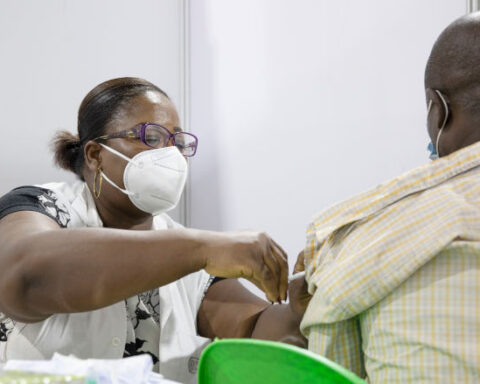Several countries in Europe and Central Asia are reporting an explosion in coronavirus cases amid warnings from the World Health Organization (WHO) that a new “west-to-east tidal wave” of the super-contagious Omicron variant could lead to more than half the population of Europe catching COVID-19 within the next two months.
In Southeastern Europe, Bulgaria reached a record-high number of new infections at 7,062 on January 12, official data showed.
Bulgaria is the European Union’s least vaccinated member state, with just over 28 percent of the 6.9 million inhabitants fully vaccinated.
Infections have seen a spike since the beginning of the year, surpassing a previous peak set in late October.
The total death toll is 31,761, with 89 more deaths over the past 24 hours.
Despite the rising number of cases, anti-vaccine protests, organized by the ultranationalist Revival party, are expected in Sofia on January 12 despite appeals by the new centrist government to vaccine-skeptic Bulgarians to get the jab.
In Central Asia, neighbors Kyrgyzstan and Kazakhstan also reported spikes in new cases on January 12 as both countries said the Omicron variant of the virus was now spreading on their territories.
Kyrgyzstan reported its first Omicron cases on January 12, and registered a total of 465 new coronavirus infections — a five-month high.
Kazakh health authorities reported the same day that the country had registered over 8,000 cases from the last seven days, almost three times more than in the previous seven-day period.
The surge in cases came a day after Hans Kluge, the WHO’s regional director for Europe, warned that more than half the population of the continent will likely be infected by March, in what he called a new “west-to-east tidal wave” sweeping across the continent.
The WHO’s European region covers 53 countries and territories, including several in Central Asia, and Kluge said Omicron is fast becoming the dominant variant in the western countries and is now spreading to the Balkans.
Modelling for the European region suggests that a peak of more than 12 million infections per day would be reached by mid-January. Country by country, peaks are expected to vary considerably, with later peaks in Central Asia, according to specialists.
Kluge called on countries with no previous rises in cases of the Omicron strain to use the time to introduce precautionary measures and prioritize vaccinating at-risk populations.
There is a “closing window of opportunity” for countries to prevent their health systems from being overwhelmed, he warned.
Kluge stressed that approved vaccines provide good protection against severe disease and death, including for Omicron, but also called for new vaccines that better protect against transmission, saying that repeating booster doses of the original COVID-19 vaccines is not a viable strategy.
The World Bank, meanwhile, provided a fresh assessment of the coronavirus pandemic on the world economy, predicting that global economic growth will decelerate in 2022 as Omicron risks exacerbating labor shortages and supply-chain backups.
In its latest Global Economic Prospects report, it cut its forecast for world economic growth this year to 4.1 percent after the 5.5 percent rebound last year.
The warnings came exactly two years after the announcement of the first person dying of a virus that later was identified as COVID-19. The death was that of a 61-year-old man in Wuhan, China, where the illness was first detected.
Since January 11, 2020, known fatalities in the pandemic have soared to nearly 5.5 million.






